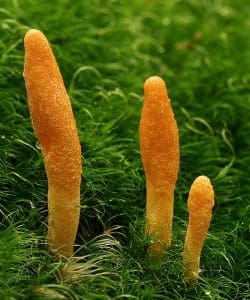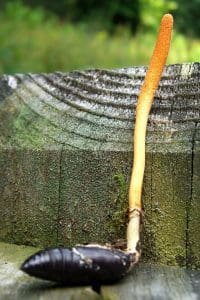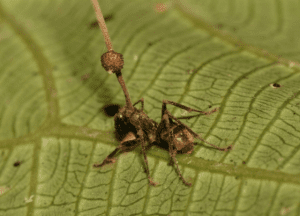Scarlet Caterpillar Club / Summer / Autumn / Edible
The Scarlet Caterpillar Club, scientifically known as Cordyceps militaris, is a mesmerizing fungus that captivates naturalists and foragers alike. With its vibrant, neon-orange club-shaped fruiting bodies, this unique species emerges from the depths of the earth, often attached to the pupae of moths.
Its intriguing lifecycle, medicinal potential, and entomopathogenic properties weave a captivating tale of nature’s intricate interactions.
Let’s embark on a journey to unravel the captivating story and extraordinary features of the Scarlet Caterpillar Club, an enchanting member of the Cordyceps fungi family
Scientific Name
Cordyceps militaris
Common Names
Scarlet Caterpillar Club
Family
Cordycipitaceae
Habitat
They are found In grassland or on mossy woodland edges, always attached to a moth pupa below the ground.
Description
This species is part of the Cordyceps family which are found worldwide. The most famous member of the family is Ophiocordyceps unilateralis, quite often called the ‘zombie ant fungus’ whose method of spore dispersal is through parasitising insects. Researchers believe that the insect picks up the fungus while foraging for food, the fungus makes its way deep into its hosts body, eventually taking over and controlling the insect’s behaviour. The fungus then makes its host climb to a high point, usually a branch and latch on, locking it in place. After a few days, the fungus’s fruiting body begins to emerge from its host’s body, where it then sends its spores out to infect more insects.
The Scarlet Caterpillar Club grows on the underground pupae of moths, turning them into a mushy mess and then pushing up its fruiting body that looks like a bright orange club.
Identifying Features of the Scarlet Caterpillar Club:
Cap:
The fungus forms a club-shaped, orange/red fruiting body, which grows out of dead underground pupae. They are between 1–8 cm high. The inner flesh is white to pale orange.
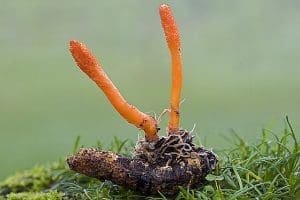
Smell:
No distinct smell
Spores:
White.
Uses of the Scarlet Caterpillar Club
Cooking with Scarlet Caterpillar Club
They are more often used as medicine than as food, but I like them in dishes such as soups, broths and stew. They are quite tough and chewy so they need quite a long cooking time.
I also really like getting a pan crazy hot (almost smoking hot like you would if searing a steak) then frying these off in it and serving with salt and pepper.
Harvesting
They are thought to be quite rare so I generally don’t gather them often from the wild but they are widely cultivated in China and are for sale in lots of Chinese supermarkets.
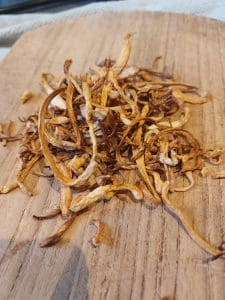
Known hazards of the Scarlet Caterpillar Club
Studies have found that excessive use of this species can cause pressure on the function of the liver and kidneys, potentially leading to damage.
Potential lookalikes for Scarlet Caterpillar Club
Could potential be confused with the Yellow Staghorn (Calocera viscosa) but this is branched and grows on dead wood.
Extra Notes
Cordyceps have been used for thousands of years in Traditional Chinese medicine and many are being investigated by western scientists too. The main medicinal properties are because of the chemicals found in the mushroom namely cordycepin, cordymin, polysaccharides, glycoprotein and ergosterol. Animal and lab studies suggest they have the potential to improve heart health and fight inflammation, cancer, diabetes and ageing.
As a word of warning though, there is limited research on humans and there is no consensus on dosages so please do some of your own independent research if you’re interested in this type of thing.
References:
https://www.healthline.com/nutrition/cordyceps-benefits
https://www.first-nature.com/fungi/cordyceps-militaris.php
https://www.ncbi.nlm.nih.gov/pmc/articles/PMC3909570/
https://www.sciencedirect.com/science/article/pii/S2667142523000143



